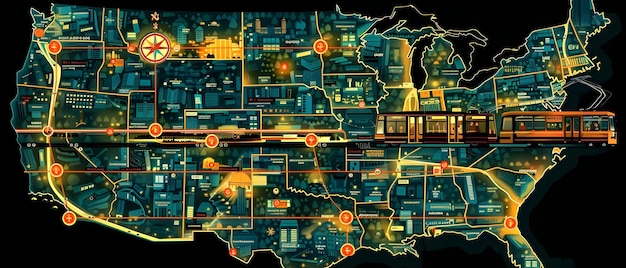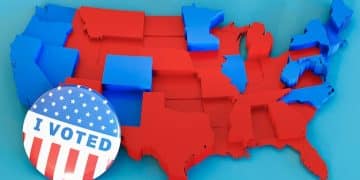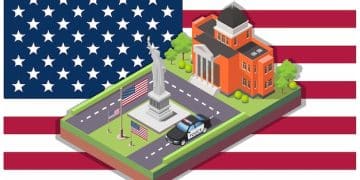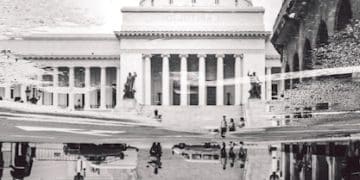Understanding the Different Forms of Local Government in the US

Local government in the US encompasses several forms, including city, county, township, and special district governments, each with distinct structures and functions to address specific community needs and ensure citizen representation.
Understanding the diverse forms of local government is crucial for every citizen. In the United States, local government isn’t just a single entity, but a collection of different structures designed to meet the specific needs of communities. So, what are the different forms of local government and how do they function? Let’s delve into the details.
What is local government?
Local government is the level of government below state and national levels. It’s the government closest to the people, directly impacting daily lives through services like schools, police, fire protection, and infrastructure maintenance. It operates within powers granted by the state.
Understanding its structure is crucial for civic engagement. Different forms exist to cater to varied population sizes and community needs.
The role of local government in the US
Local government plays a pivotal role in the everyday lives of citizens. It is responsible for providing essential services and ensuring public safety, making it a direct and vital link between the populace and the governing authority.
- Ensuring public safety through local police and fire departments.
- Managing education via local school districts.
- Maintaining infrastructure like roads, bridges, and public transit.
- Providing social services and community support programs.
These services are funded primarily through local taxes, fees, and grants from state and federal entities. The efficiency and effectiveness of local government directly impact the quality of life for its residents.

Effective local governance requires citizen participation, transparency, and accountability. Local government decisions must reflect the community’s needs and aspirations.
County governments
County governments are administrative divisions of a state, typically overseeing rural areas. They provide services that aren’t incorporated into city or municipal governments such as law enforcement, road maintenance, and public health services.
Understanding the structure and function of county governments is essential for residents living outside of city limits.
Organization of county governments
County governments are typically structured with an elected board of commissioners or supervisors. This board acts as the legislative body, setting policies and approving budgets.
In addition to the board, there are often separately elected officials like the sheriff, county clerk, treasurer, and assessor. These officials oversee specific county functions and departments.
County governments are vital in providing services to unincorporated areas and coordinating regional planning. They also manage courts, record-keeping, and election administration.
City governments
City governments, also known as municipal governments, are established in urban areas. They are responsible for providing a wide range of services to residents, including water, sewer, sanitation, and recreational programs.
The structure can vary, but the most common forms are mayor-council, council-manager, and commission governments.
Types of city government structures
The form of a city government significantly impacts how decisions are made and services are delivered. Understanding these structures is important for civic engagement.
Mayor-council: Features an elected mayor as the executive and an elected council as the legislative body. The mayor can be either a “strong mayor” with significant executive powers or a “weak mayor” with limited authority.
- Council-manager: An elected council hires a professional city manager to oversee daily operations. The mayor is typically a member of the council.
- Commission: Voters elect individual commissioners to head specific departments, such as police, fire, and public works. Each commissioner acts as the executive head of their department.
- Town meeting: A form of direct democracy where eligible voters gather to make decisions, set budgets, and elect officials. This is more common in smaller towns.

Each structure has its distinct advantages and disadvantages. The choice depends on the specific needs and preferences of the community.
Township governments
Township governments are a form of local government found primarily in the Northeastern and Midwestern United States. They are smaller than counties but larger than cities or villages, overseeing a defined geographic area.
Townships often provide services such as road maintenance, fire protection, and local parks. They operate with a board of trustees or supervisors elected by residents.
Functions of township governments
Township governments play a critical role in managing services and resources at the local level. Their functions are essential to the well-being of their residents.
Townships provide a range of services, including road maintenance, snow removal, trash collection, and zoning enforcement. They support local schools, parks, and recreational facilities.
Townships sometimes offer public safety services, such as volunteer fire departments and emergency medical services.
Special district governments
Special district governments are independent, special-purpose governmental units that exist separately from general-purpose governments such as cities, counties, and townships. These districts are created to deliver specific services or address specific needs.
They are often formed to provide services that cross jurisdictional boundaries or require specialized expertise. Examples include water districts, fire protection districts, and park districts.
Examples and purpose of special districts
Special districts are created to meet specific needs within a defined geographic area. They are separate legal entities with the power to levy taxes and issue bonds.
Some common examples include school districts to manage education, water districts to manage water resources, and fire protection districts to provide fire suppression services. These districts can be formed to address transportation, flood control, or other infrastructure requirements.
Special districts are governed by a board of directors or commissioners, who may be elected by voters or appointed by other governmental entities.
Interrelation of local governments
Local governments often work together to address regional issues and provide efficient services. This interrelation is essential for effective governance.
Collaborative agreements and partnerships allow entities to share resources, coordinate planning, and avoid duplication of efforts.
Regional planning and cooperation
Regional planning involves multiple local governments collaborating to develop comprehensive plans and strategies for transportation, land use, and economic development.
Cooperation can result in economies of scale, improved service delivery, and enhanced ability to tackle complex challenges. Regional planning organizations (RPOs) and councils of governments (COGs) often facilitate coordination.
Interlocal agreements can also allow local governments to share services, such as police or fire protection, or jointly operate facilities like water treatment plants.
Citizen engagement in local government
Citizen engagement is crucial for a responsive and accountable local government. It ensures that decisions reflect the priorities and values of the community.
Opportunities for engagement include attending public meetings, volunteering on advisory boards, and participating in elections.
Importance of voting and participation
Voting is one of the most fundamental ways citizens can influence local government. Elections determine who represents residents and makes decisions on their behalf.
- Understanding candidates and local issues is essential for informed voting.
- Participation in public meetings and hearings allows citizens to voice their opinions and concerns.
- Volunteering on advisory boards or committees can contribute to policy development and community projects.
| Key Point | Brief Description |
|---|---|
| 🏛️ County Governments | Administer rural areas, providing law enforcement and road maintenance. |
| 🏙️ City Governments | Offer services like water, sewer, and sanitation in urban areas. |
| 🏘️ Township Governments | Manage local services in smaller, defined geographic areas. |
| 🔥 Special Districts | Provide specific services like fire protection or water management independently. |
Frequently Asked Questions
▼
The main types include county, city (municipal), township, and special district governments. Each type has distinct responsibilities and structures to serve different community needs.
▼
City governments serve incorporated urban areas, providing services such as water and sanitation. County governments administer larger geographic areas including rural areas, and offer broader services like law enforcement.
▼
Special districts are independent entities created to address specific needs, such as water management, fire protection, or education. They operate separately from general-purpose governments.
▼
Citizens can influence local government by voting in elections, attending public meetings, volunteering on advisory boards, and participating in community discussions to express their views and concerns.
▼
Local government is essential for community development because it provides essential services, manages infrastructure, ensures public safety, and fosters citizen involvement, contributing to a higher quality of life.
Conclusion
Understanding the diverse forms of local government and how they function is vital for effective civic engagement. Each form—county, city, township, and special district—plays a unique role in providing essential services and shaping communities. By participating in local governance, citizens can ensure their voices are heard and contribute to the well-being of their communities.





